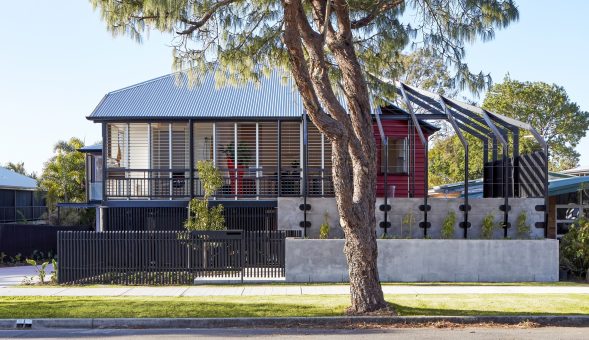
The Australian Institute of Architects Queensland Chapter has welcomed the Queensland Government’s announcement to extend the rental use of granny flats and secondary dwellings to the wider community instead of just family members.
Queensland Chapter President, Amy Degenhart, said as the peak body for the built environment, the Institute had advocated for the desperately needed solution, to provide immediate relief to the current rental shortfall.
“Optimising the use of existing housing for rental accommodation is simply a no-brainer as an immediate step to help ameliorate homelessness and the lack of affordable, well-located accommodation for smaller households,” Ms Degenhart said.
“This shift in legislative focus will also encourage resilient design of new homes, incentivising the planning of a larger house that can also become two smaller homes – or a home and an office – providing flexibility as families change over time.”
“With the new rules for residential tenancies, banks and valuers can acknowledge the additional investment required to be life-cycle proactive from the start. Rather than having to move from the family home, it could simply be a matter of adopting clever design and adding a few extra plumbing points in the original build.”
“Most architects in the housing sector have included concepts of compartmentalisation for decades, providing an excellent flexibility of use for their clients,” Ms Degenhart said.
The Queensland Government’s 60 per cent target for all new dwellings to come from infill development by 2040 makes greyfield development in established neighbourhoods a necessity. Capturing the surplus capacity of existing infrastructure and facilities adds the benefits of sustainable to this option for urban development.
“There are plenty of missing middle housing typologies, such as low-rise apartments, small-lot infill subdivisions, terrace housing, townhouses, duplexes, and now secondary dwellings, but most of these rely heavily on the town planning consent, which may delay and restrict the potential outcomes,” she said.
“But concepts such as the baugruppen or manor house, which consists of three or four independently titled dwellings that form what looks like a single large home on a standard suburban lot, could be a valuable addition to the available options to create market affordable missing middle housing.”
The Low-Rise Housing Diversity Code (LRHDC), introduced recently in New South Wales, is one example of innovative legislation that facilitates this typology to encourage housing diversity and affordability, with the bonus of rejuvenating deteriorating neighborhoods at the same time. This Brassy Street project (image) containing multiple new dwellings and an old Queenslander is a great example of this approach.
“Whether it’s through granny flats or greyfield development, good architecture will make the difference to both affordability and community outcomes,” Ms Degenhart said.
The Australian Institute of Architects Queensland Chapter has welcomed the Queensland Government’s announcement to extend the rental use of granny flats and secondary dwellings to the wider community instead of just family members.
Queensland Chapter President, Amy Degenhart, said as the peak body for the built environment, the Institute had advocated for the desperately needed solution, to provide immediate relief to the current rental shortfall.
“Optimising the use of existing housing for rental accommodation is simply a no-brainer as an immediate step to help ameliorate homelessness and the lack of affordable, well-located accommodation for smaller households,” Ms Degenhart said.
“This shift in legislative focus will also encourage resilient design of new homes, incentivising the planning of a larger house that can also become two smaller homes – or a home and an office – providing flexibility as families change over time.”
“With the new rules for residential tenancies, banks and valuers can acknowledge the additional investment required to be life-cycle proactive from the start. Rather than having to move from the family home, it could simply be a matter of adopting clever design and adding a few extra plumbing points in the original build.”
“Most architects in the housing sector have included concepts of compartmentalisation for decades, providing an excellent flexibility of use for their clients,” Ms Degenhart said.
The Queensland Government’s 60 per cent target for all new dwellings to come from infill development by 2040 makes greyfield development in established neighbourhoods a necessity. Capturing the surplus capacity of existing infrastructure and facilities adds the benefits of sustainable to this option for urban development.
“There are plenty of missing middle housing typologies, such as low-rise apartments, small-lot infill subdivisions, terrace housing, townhouses, duplexes, and now secondary dwellings, but most of these rely heavily on the town planning consent, which may delay and restrict the potential outcomes,” she said.
“But concepts such as the baugruppen or manor house, which consists of three or four independently titled dwellings that form what looks like a single large home on a standard suburban lot, could be a valuable addition to the available options to create market affordable missing middle housing.”
The Low-Rise Housing Diversity Code (LRHDC), introduced recently in New South Wales, is one example of innovative legislation that facilitates this typology to encourage housing diversity and affordability, with the bonus of rejuvenating deteriorating neighborhoods at the same time. This Brassy Street project (image) containing multiple new dwellings and an old Queenslander is a great example of this approach.
“Whether it’s through granny flats or greyfield development, good architecture will make the difference to both affordability and community outcomes,” Ms Degenhart said.
Media contact: Anna Svensdotter, Queensland State Manager, Australian Institute of Architects on 0402 852 645 or anna.svensdotter@architecture.com.au
